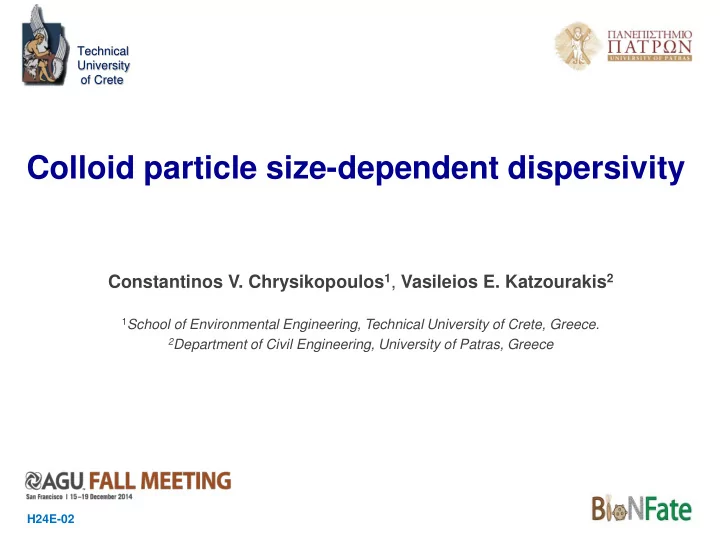

Technical University of Crete Colloid particle size-dependent dispersivity Constantinos V. Chrysikopoulos 1 , Vasileios E. Katzourakis 2 1 School of Environmental Engineering, Technical University of Crete, Greece. 2 Department of Civil Engineering, University of Patras, Greece H24E-02
Graphical abstract
Previous studies Early breakthrough of colloids as compared to conservative tracers “Larger colloids are restricted by the size exclusion effect from sampling all paths” References: Toran and Palumbo,1992 Powelson et al., 1993 Grindrod et al., 1996 Dong et al., 2002 Keller et al., 2004. Vasiliadou and Chrysikopoulos, 2011 Sinton et al., 2012
Effective dispersion in a uniform fracture Infinitesimally small particles 2-D particle tracking (x,z) d p =5 × 10 -6 m 1-D particle tracking (x) with effective U & D d p =5 × 10 -6 m The effective particle velocity is increased, while the overall particle dispersion is reduced compared to Taylor dispersion, but with a tendency to increase with increasing particle size over a certain range of particle Snapshots of 5000-particle plume (t=70 d, b=10 -4 m) diameters. Reference: James and Chrysikopoulos, J. Colloid and Interface Science , 2003.
Early work on particle size-dependent dispersivity (Micromodel) Mass recovered: M r = 100% Reference: Auset and Keller, Water Resources Research , 2004.
Early work on particle size-dependent dispersivity (Column study) Mass recovered: M r = 28.8 to 41.0 % Reference: Keller, Sirivithayapakorn, Chrysikopoulos, Water Resources Research , 2004.
Question: Should dispersivity decrease or increase with colloid particle size? Another look at particle size-dependent dispersivity
Materials and methods Columns: diameter = 2.5 cm length = 15 & 30 cm packed with glass beads (d c =2 mm) placed horizontally to minimize gravity effects Colloids: fluorescent polystyrene microspheres d p = 28, 300, 600, 1000, 1750, 2100, 3000, 5000 and 5500 nm fluorescence spectrophotometry Tracer: bromide in the form of NaBr (10 -5 M) ion chromatography “instantaneous” pulse Source: d p /d c : <0.00275 below the straining and wedging threshold of >0.004 (Johnson et al., 2010) or >0.003 (Bradford and Bettahar, 2006) Transport experiments were performed under unfavorable colloid attachment conditions (pH=7, I s =0.1 mM).
Mathematical Model Governing transport equation (Sim and Chrysikopoulos, 1998) Colloid attachment onto the solid matrix Initial and boundary conditions
Analytical solution (Thomas and Chrysikopoulos, JoCIS , 2007) I 1 = Modified Bessel function (first-kind, order-one)
Figure 1. Early breakthrough
Figure 2. Breakthrough curves for two different colloids
Figure 3. Longitudinal dispersivity as a function of colloid diameter. Hypothesis that the population regression is linear: Accepted F test-Hypothesis that the slope=0: Rejected
Figure 4. Longitudinal dispersivity (averaged) as a function of colloid diameter.
Figure 5. Longitudinal dispersivity as a function of interstitial velocity
Mass Recovery Zeroth absolute temporal moment (Quantifies the total mass in the concentration distribution curve)
Figure 6. Mass recovery as a function of particle size
Scaling of D L with Peclet number (Delgado, 2007) 250 < Pe m < 10 5 Molecular diffusion is negligible. Mechanical dispersion is the governing dispersion process.
Figure 7. Scaling of the longitudinal hydrodynamic dispersion coefficients (circles for colloids, and triangles for tracer) with Péclet number.
Figure 8. Longitudinal dispersivity as a function of interstitial velocity
Figure 9. Compilation of 432 longitudinal dispersivities as a function of length scale. Molecular sized solutes are represented by gray symbols, and colloids/biocolloids by various colored symbols. The solid line is a standard linear regression line. References: S-M [Schulze-Makuch, 2005] CLH [Chrysikopoulos et al., 2000] DHC [Dela Barre et al., 2002] BMN [Baumann et al., 2002] CPK [Chrysikopoulos et al., 2011] AC [Anders and Chrysikopoulos, 2005] KSC [Keller et al., 2004] VC [Vasiliadou & Chrysikopoulos, 2011] SC [Syngouna & Chrysikopoulos, 2011] CSVK [Chrysikopoulos et al., 2012] BW [Bauman and Werth, 2004] BTN [Baumann et al., 2010]
Explanation Figure 10. Schematic illustration of (a) solute and (b) colloid transport in water saturated porous media. The tracer can sample the entire velocity spectrum within the parabolic profile (green region). Colloids do not sample the truncated portion of the parabolic velocity profile (red region). Also, colloids do not enter pore spaces with opening smaller than d p , which essentially leads to reduction of effective porosity.
Summary • Colloid dispersivity is not only a function of scale, but also a function of colloid diameter and interstitial velocity. • Contrary to earlier results, colloid dispersivity increases with increasing colloid diameter and interstitial velocity. • The observed increase in colloid dispersion is attributed to reduction of the effective porosity, which overbalances the reduction of colloid dispersion caused by colloid exclusion from the lower velocity regions. • Fitted dispersion coefficients based on tracer data should not be used to analyze colloid data. • The universal dispersivity line should be used with caution.
Thank you for your attention
Recommend
More recommend